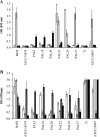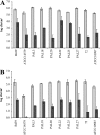Air-liquid interface biofilms of Bacillus cereus: formation, sporulation, and dispersion
- PMID: 17209076
- PMCID: PMC1828785
- DOI: 10.1128/AEM.01781-06
Air-liquid interface biofilms of Bacillus cereus: formation, sporulation, and dispersion
Abstract
Biofilm formation by Bacillus cereus was assessed using 56 strains of B. cereus, including the two sequenced strains, ATCC 14579 and ATCC 10987. Biofilm production in microtiter plates was found to be strongly dependent on incubation time, temperature, and medium, as well as the strain used, with some strains showing biofilm formation within 24 h and subsequent dispersion within the next 24 h. A selection of strains was used for quantitative analysis of biofilm formation on stainless steel coupons. Thick biofilms of B. cereus developed at the air-liquid interface, while the amount of biofilm formed was much lower in submerged systems. This suggests that B. cereus biofilms may develop particularly in industrial storage and piping systems that are partly filled during operation or where residual liquid has remained after a production cycle. Moreover, depending on the strain and culture conditions, spores constituted up to 90% of the total biofilm counts. This indicates that B. cereus biofilms can act as a nidus for spore formation and subsequently can release their spores into food production environments.
Figures





Similar articles
-
Antagonism between Bacillus cereus and Pseudomonas fluorescens in planktonic systems and in biofilms.Biofouling. 2008;24(5):339-49. doi: 10.1080/08927010802239154. Biofouling. 2008. PMID: 18576180
-
Comparative analysis of biofilm formation by Bacillus cereus reference strains and undomesticated food isolates and the effect of free iron.Int J Food Microbiol. 2015 May 4;200:72-9. doi: 10.1016/j.ijfoodmicro.2015.02.005. Epub 2015 Feb 12. Int J Food Microbiol. 2015. PMID: 25700364
-
Biofilm formation and sporulation by Bacillus cereus on a stainless steel surface and subsequent resistance of vegetative cells and spores to chlorine, chlorine dioxide, and a peroxyacetic acid-based sanitizer.J Food Prot. 2005 Dec;68(12):2614-22. doi: 10.4315/0362-028x-68.12.2614. J Food Prot. 2005. PMID: 16355833
-
Bacillus cereus spores and toxins - The potential role of biofilms.Food Microbiol. 2020 Sep;90:103493. doi: 10.1016/j.fm.2020.103493. Epub 2020 Mar 26. Food Microbiol. 2020. PMID: 32336372 Review.
-
Beneficial biofilm formation by industrial bacteria Bacillus subtilis and related species.J Biosci Bioeng. 2006 Jan;101(1):1-8. doi: 10.1263/jbb.101.1. J Biosci Bioeng. 2006. PMID: 16503283 Review.
Cited by
-
Indoor Air Quality and Potential Health Risk Impacts of Exposure to Antibiotic Resistant Bacteria in an Office Rooms in Southern Poland.Int J Environ Res Public Health. 2018 Nov 21;15(11):2604. doi: 10.3390/ijerph15112604. Int J Environ Res Public Health. 2018. PMID: 30469413 Free PMC article.
-
Effects of Synthetic Tetronamides and Methylated Denigrins on Bacterial Quorum Sensing and Biofilm Formation.ACS Omega. 2023 Oct 2;8(41):37798-37807. doi: 10.1021/acsomega.3c01729. eCollection 2023 Oct 17. ACS Omega. 2023. PMID: 37867724 Free PMC article.
-
Antimycobacterial Precatorin A Flavonoid Displays Antibiofilm Activity against Mycobacterium bovis BCG.ACS Omega. 2023 Oct 20;8(43):40665-40676. doi: 10.1021/acsomega.3c05703. eCollection 2023 Oct 31. ACS Omega. 2023. PMID: 37929145 Free PMC article.
-
The genomic characterisation and comparison of Bacillus cereus strains isolated from indoor air.Gut Pathog. 2021 Jan 30;13(1):6. doi: 10.1186/s13099-021-00399-4. Gut Pathog. 2021. PMID: 33516253 Free PMC article.
-
Biofilm Production by Enterotoxigenic Strains of Bacillus cereus in Different Materials and under Different Environmental Conditions.Microorganisms. 2020 Jul 17;8(7):1071. doi: 10.3390/microorganisms8071071. Microorganisms. 2020. PMID: 32709126 Free PMC article.
References
-
- Andersson, A., U. Ronner, and P. E. Granum. 1995. What problems does the food industry have with the spore-forming pathogens Bacillus cereus and Clostridium perfringens? Int. J. Food Microbiol. 28:145-155. - PubMed
-
- Boles, B. R., M. Thoendel, and P. K. Singh. 2005. Rhamnolipids mediate detachment of Pseudomonas aeruginosa from biofilms. Mol. Microbiol. 57:1210-1223. - PubMed
MeSH terms
Substances
LinkOut - more resources
Full Text Sources
Molecular Biology Databases

